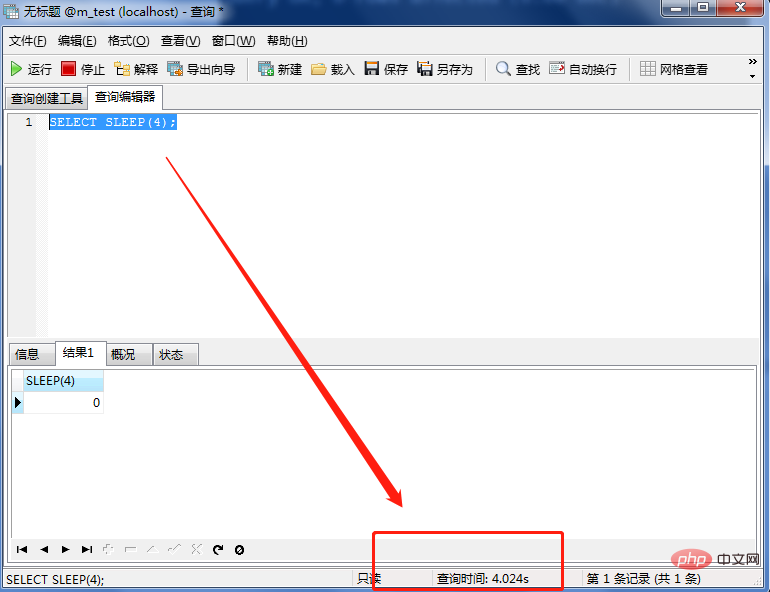# Regarding slow SQL, I chatted with the interviewer for a long time. The interviewer was also very humble and always nodded. I thought my answer was okay. Finally, I said, "Go back and wait for the notification!".

#So, I decided to share this slow SQL technology with you. I hope that next time you encounter a similar interview, you can get the offer you want smoothly and easily.
The greatest joy in life is that everyone says you can’t do it, but you complete it!
MySQL's slow query log is a log record provided by MySQL. It is used to record statements in MySQL whose query time exceeds (greater than) the set threshold (long_query_time) and records them in the slow query log. middle.
Among them, the default value of long_query_time is 10, and the unit is seconds. That is to say, by default, if your SQL query time exceeds 10 seconds, it is regarded as slow SQL.
In MySQL, the slow SQL log is not turned on by default, which means that even if a slow SQL occurs, it will not tell you. If you need to know which SQL is Slow SQL requires us to manually enable the slow SQL log.
Regarding whether slow SQL is enabled, we can check it through the following command:
-- 查看慢查询日志是否开启 show variables like '%slow_query_log%';

Through the command, we can see that the slow_query_log item is OFF, indicating that our slow SQL log is not turned on. In addition, we can also see the directory where our slow SQL logs are stored and the name of the log file.
Let's enable the slow SQL log and execute the following command:
set global slow_query_log = 1;
It should be noted here that what is enabled here is our current database, and it will be invalid after we restart the database.
After turning on the slow SQL log, check again:

slow_query_log item has become ON means the activation is successful.
As mentioned above, the default time of slow SQL is 10 seconds. We can see the default time of our slow SQL through the following command:
show variables like '%long_query_time%';

We cannot always use this default value. Many businesses may require shorter or longer time, so at this time, we need to modify the default time. The modification command is as follows:
set long_query_time = 3;
The modification is completed, let’s see if it has been changed to 3 seconds.

Note here: If you want it to take effect permanently, you also need to modify the configuration file my under MySQL. cnf file.
[mysqld] slow_query_log=1 slow_query_log_file=/var/lib/mysql/atguigu-slow.log long_query_time=3 log_output=FILE
Note: Different operating systems have different configurations.
In Linux operating system
Add
log-slow-queries=/var/lib/mysql/slowquery.log in the mysql configuration file my.cnf (Specify the log file storage location, which can be empty. The system will give a default file host_name-slow.log)
long_query_time=2 (record the time exceeded, the default is 10s)
log-queries-not-using-indexes (log下来没有使用索引的query,可以根据情况决定是否开启)
log-long-format (如果设置了,所有没有使用索引的查询也将被记录)
Windows操作系统中
在my.ini的[mysqld]添加如下语句:
log-slow-queries = E:\web\mysql\log\mysqlslowquery.log
long_query_time = 3(其他参数如上)
执行一条慢SQL,因为我们前面已经设置好了慢SQL时间为3秒,所以,我们只要执行一条SQL时间超过3秒即可。
SELECT SLEEP(4);

该SQL耗时4.024秒,下面我们就来查看慢SQL出现了多少条。
使用命令:
show global status like '%Slow_queries%';

找到慢SQL日志文件,打开后就会出现类似下面这样的语句;
# Time: 2021-07-20T09:17:49.791767Z # User@Host: root[root] @ localhost [] Id: 150 # Query_time: 0.002549 Lock_time: 0.000144 Rows_sent: 1 Rows_examined: 4079 SET timestamp=1566292669; select * from city where Name = 'Salala';
简单说明:
1.Time 该日志记录的时间
2.User @Host MySQL登录的用户和登录的主机地址
3.Query_time一行 第一个时间是查询的时间、第二个是锁表的时间、第三个是返回的行数、第四个是扫描的行数
4.SET timestamp 这一个是MySQL查询的时间
5.sql语句 这一行就很明显了,表示的是我们执行的sql语句
切记
If you set long_query_time=0, it means that all our query SQL statements will be output to the slow SQL log file.
Usually we have two ways to locate slow SQL:
The first way: locate slow querySQL can be through two representations Determine
SQL
如果开启了慢SQL日志后,可能会有大量的慢SQL日志产生,此时再用肉眼看,那是不太现实的,所以大佬们就给我搞了个工具:mysqldumpslow。
mysqldumpslow能将相同的慢SQL归类,并统计出相同的SQL执行的次数,每次执行耗时多久、总耗时,每次返回的行数、总行数,以及客户端连接信息等。
通过命令
mysqldumpslow --help
可以看到相关参数的说明:
~# mysqldumpslow --help
Usage: mysqldumpslow [ OPTS... ] [ LOGS... ]
Parse and summarize the MySQL slow query log. Options are
--verbose verbose
--debug debug
--help write this text to standard output
-v verbose
-d debug
-s ORDER what to sort by (al, at, ar, c, l, r, t), 'at' is default
al: average lock time
ar: average rows sent
at: average query time
c: count
l: lock time
r: rows sent
t: query time
-r reverse the sort order (largest last instead of first)
-t NUM just show the top n queries
-a don't abstract all numbers to N and strings to 'S'
-n NUM abstract numbers with at least n digits within names
-g PATTERN grep: only consider stmts that include this string
-h HOSTNAME hostname of db server for *-slow.log filename (can be wildcard),
default is '*', i.e. match all
-i NAME name of server instance (if using mysql.server startup script)
-l don't subtract lock time from total time比较常用的参数有这么几个:
-s 指定输出的排序方式 t : 根据query time(执行时间)进行排序; at : 根据average query time(平均执行时间)进行排序;(默认使用的方式) l : 根据lock time(锁定时间)进行排序; al : 根据average lock time(平均锁定时间)进行排序; r : 根据rows(扫描的行数)进行排序; ar : 根据average rows(扫描的平均行数)进行排序; c : 根据日志中出现的总次数进行排序; -t 指定输出的sql语句条数; -a 不进行抽象显示(默认会将数字抽象为N,字符串抽象为S); -g 满足指定条件,与grep相似; -h 用来指定主机名(指定打开文件,通常慢查询日志名称为“主机名-slow.log”,用-h exp则表示打开exp-slow.log文件);
mysqldumpslow常用的使用方式如下:
# mysqldumpslow -s c slow.log
如上一条命令,应该是mysqldumpslow最简单的一种形式,其中-s参数是以什么方式排序的意思,c指代的是以总数从大到小的方式排序。-s的常用子参数有:c: 相同查询以查询条数和从大到小排序。t: 以查询总时间的方式从大到小排序。l: 以查询锁的总时间的方式从大到小排序。at: 以查询平均时间的方式从大到小排序。al: 以查询锁平均时间的方式从大到小排序。
同样的,还可以增加其他参数,实际使用的时候,按照自己的情况来。
其他常用方式:
# 得到返回记录集最多的10 个SQL mysqldumpslow -s r -t 10 /var/lib/mysql/atguigu-slow.log # 得到访问次数最多的10 个SQL mysqldumpslow -s c -t 10 /var/lib/mysql/atguigu-slow.log # 得到按照时间排序的前10 条里面含有左连接的查询语句 mysqldumpslow -s t -t 10 -g "left join" /var/lib/mysql/atguigu-slow.log # 另外建议在使用这些命令时结合| 和more 使用,否则有可能出现爆屏情况 mysqldumpslow -s r -t 10 /var/lib/mysql/atguigu-slow.log | more
接下,我们来个实际操作。
root@yunzongjitest1:~# mysqldumpslow -s t -t 3 Reading mysql slow query log from /var/lib/mysql/exp-slow.log /var/lib/mysql/yunzongjitest1-slow.log Count: 464 Time=18.35s (8515s) Lock=0.01s (3s) Rows=90884.0 (42170176), root[root]@localhost select ************ Count: 38 Time=11.22s (426s) Lock=0.00s (0s) Rows=1.0 (38), root[root]@localhost select *********** not like 'S' Count: 48 Time=5.07s (243s) Lock=0.02s (1s) Rows=1.0 (48), root[root]@localhost select ********='S'
这其中的SQL语句因为涉及某些信息,所以我都用*号将主体替换了,如果希望得到具体的值,使用-a参数。
使用mysqldumpslow查询出来的摘要信息,包含了这些内容:
Count: 464 :表示慢查询日志总共记录到这条sql语句执行的次数;
Time=18.35s (8515s):18.35s表示平均执行时间(-s at),8515s表示总的执行时间(-s t);
Lock=0.01s (3s):与上面的Time相同,第一个表示平均锁定时间(-s al),括号内的表示总的锁定时间(-s l)(也有另一种说法,说是表示的等待锁释放的时间);
Rows=90884.0 (42170176): The first value indicates the average number of rows scanned (-s ar), and the value in brackets indicates the total number of rows scanned (-s r).
The above is the detailed content of Meituan interview question: Have you ever encountered slow SQL? How was it solved?. For more information, please follow other related articles on the PHP Chinese website!




